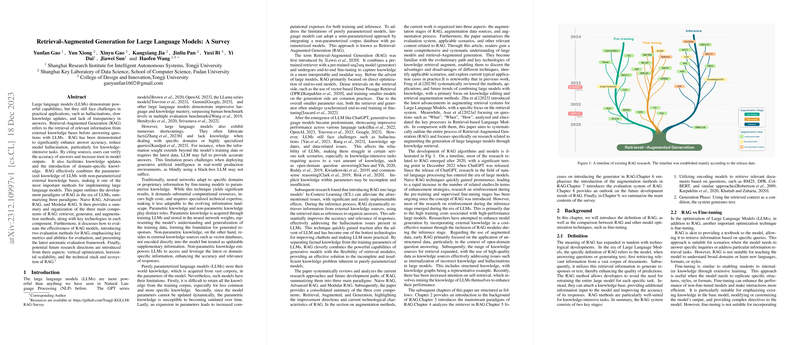Overview of Retrieval-Augmented Generation
Retrieval-Augmented Generation (RAG) combines parametric knowledge from LLMs with non-parametric knowledge sourced externally to enhance the generation of text. By linking generated output to external data, RAG provides a verifiable foundation for the information provided, often reducing hallucination issues where models generate false information. RAG is adaptable, making it a powerful tool for providing up-to-date information and transparent outputs that can be traced back to the source material.
Paradigms of RAG
RAG development has undergone a transition from Naive RAG to more sophisticated paradigms including Advanced RAG and Modular RAG. Naive RAG involves a retrieval process that retrieves relevant documents, which a generator then uses to create text responses. Despite the effectiveness of this process, its limitations pave the way for Advanced RAG. Advanced RAG addresses these limitations by optimizing the retrieval process with methods such as pre-indexing optimization and refinement of the retrieval process with techniques like recursive retrieval.
Modular RAG further advances the concept by allowing the integration of various modules which can be reconfigured based on specific tasks, offering greater flexibility and efficiency.
Core Components and Evaluation of RAG
Research on RAG spans across retrievers and generators. The core focus is on fine-tuning both components to improve answer accuracy and relevance. For instance, RAG with iterative retrieval refines the retrieval process, potentially yielding more relevant and concise information which enhances LLM performance. In terms of evaluation, frameworks like RAGAS and ARES analyze RAG systems employing metrics such as Faithfulness, Relevance, and Context Recall to measure effectiveness.
Future Directions and Horizontal Expansion
RAG has potential for vertical optimization, such as addressing long context limitations and improving robustness. Horizontal expansion has seen RAG applied across diverse domains from images to code, showcasing its flexibility and applicability. Finally, the growth of the RAG ecosystem, including technical stacks and tools, points to a future where an all-encompassing RAG platform could be a reality, maximizing the synergy between parametric and non-parametric methods and aligning with engineering needs.
The continuous improvement and diversification of RAG use cases are likely to further its performance and practical applications, creating a more powerful tool in the landscape of generative AI.
